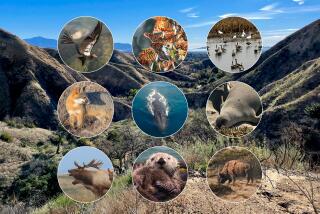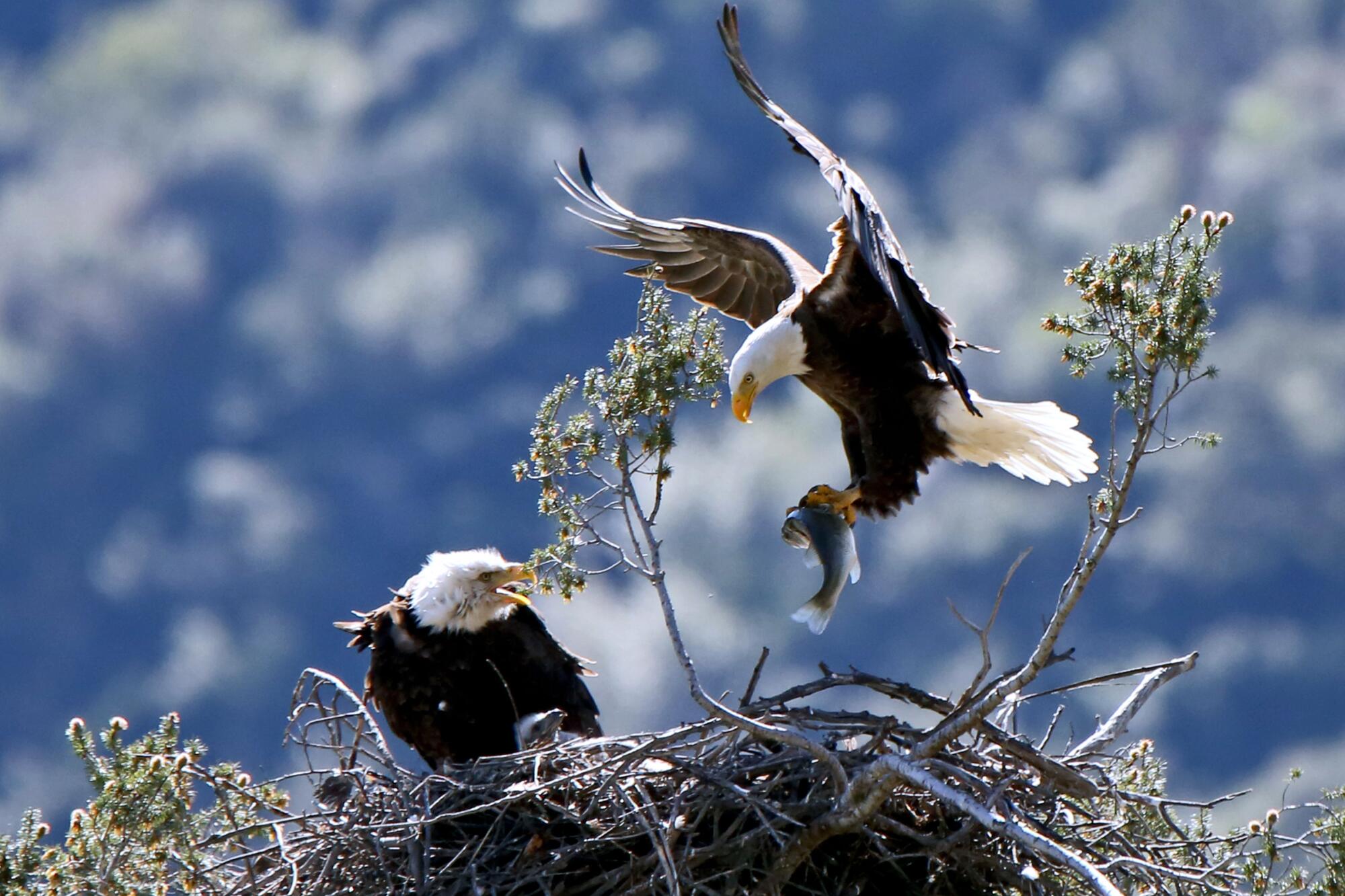
For much of the spring, a constant flow of people arrived at a dirt pullout on a mountain road a few miles above Azusa, each craving a glimpse of 10-pound celebrities with 7-foot wingspans and the charisma that politicians can only dream of.
These were bald eagles, after all, the bird that spreads its wings on every dollar bill and U.S. passport. And their nest atop a pine tree overlooking a reservoir on one side and Highway 39 on the other offered a full picture of home life for these majestic raptors. It was the first time bald eagles had nested in this part of the San Gabriel Mountains in 70 years.
Voices oh-wowed. Cameras clicked. Faces smiled, and photos and video footage immediately spread on Facebook and Instagram of two energetic fledglings braving their first flights out of the brown bundle of sticks, and shrieking like high-pitched, neighing horses when their parents returned with fresh fish for dinner.
The fledglings and their watchful parents are part of a new breed of “urban eagles” moving into Southern California and throughout the nation, displaying an unusual tolerance for the clatter and commotion of city life.
But with nature’s bounty come agonizingly complex issues for wildlife authorities as these scrappy, opportunistic and highly social creatures — which all but vanished in the 1970s — return to former native lands since transformed by urban sprawl.
The U.S. Forest Service, protector of wildlife in the San Gabriel Mountains National Monument, is facing up to a mass of conflicts: government regulation versus appreciation of nature; public access versus public safety; aggressive wildlife photographers versus eaglets trying to take wing.
Carie Battistone, a biologist with the California Department of Fish and Wildlife, summed up the situation: “Urban eagle births are definitely increasing — along with the number of people wanting to get real close to them. So, these urban eagles are a lot of work.”
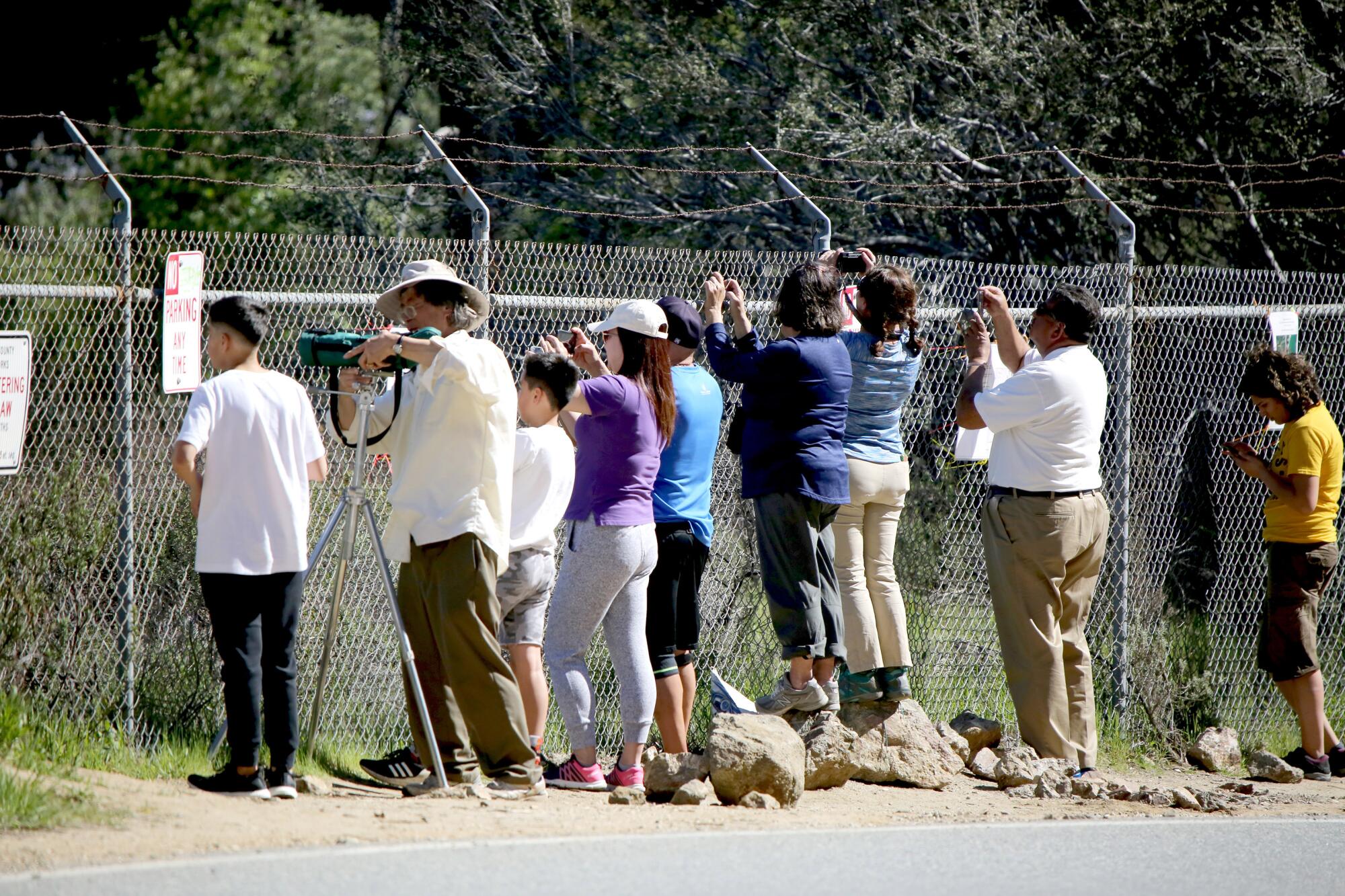
As word of the eagles’ nest above Azusa spread this year, crowds would spill out onto the two-lane highway. Law enforcement authorities arrived to secure the scene.
The “no trespassing” signs posted along a chain-link fence skirting a hairpin turn of the highway less than 100 yards from the nest are not the kind you see every day: violations, they warn in large red letters, are punishable by fines of up to $10,000.
“Those signs are intended to manage humans more than to protect the eagles,” sighed Nathan Sill, a biologist for the Forest Service whose duties included monitoring the nest. “We get some real knuckleheads, and they make it tough on all of us.”
Some eagle lovers have blocked traffic by setting up tripods in the middle of the road; others have tossed rocks at the eagles to get them to turn around and face a camera. A few have been cited for trespassing.
“We’ve had incidents,” Sill added, shaking his head, “in which fire trucks en route to a traffic accident with lights flashing and sirens blaring were unable to get through the crowd on the highway.”
::
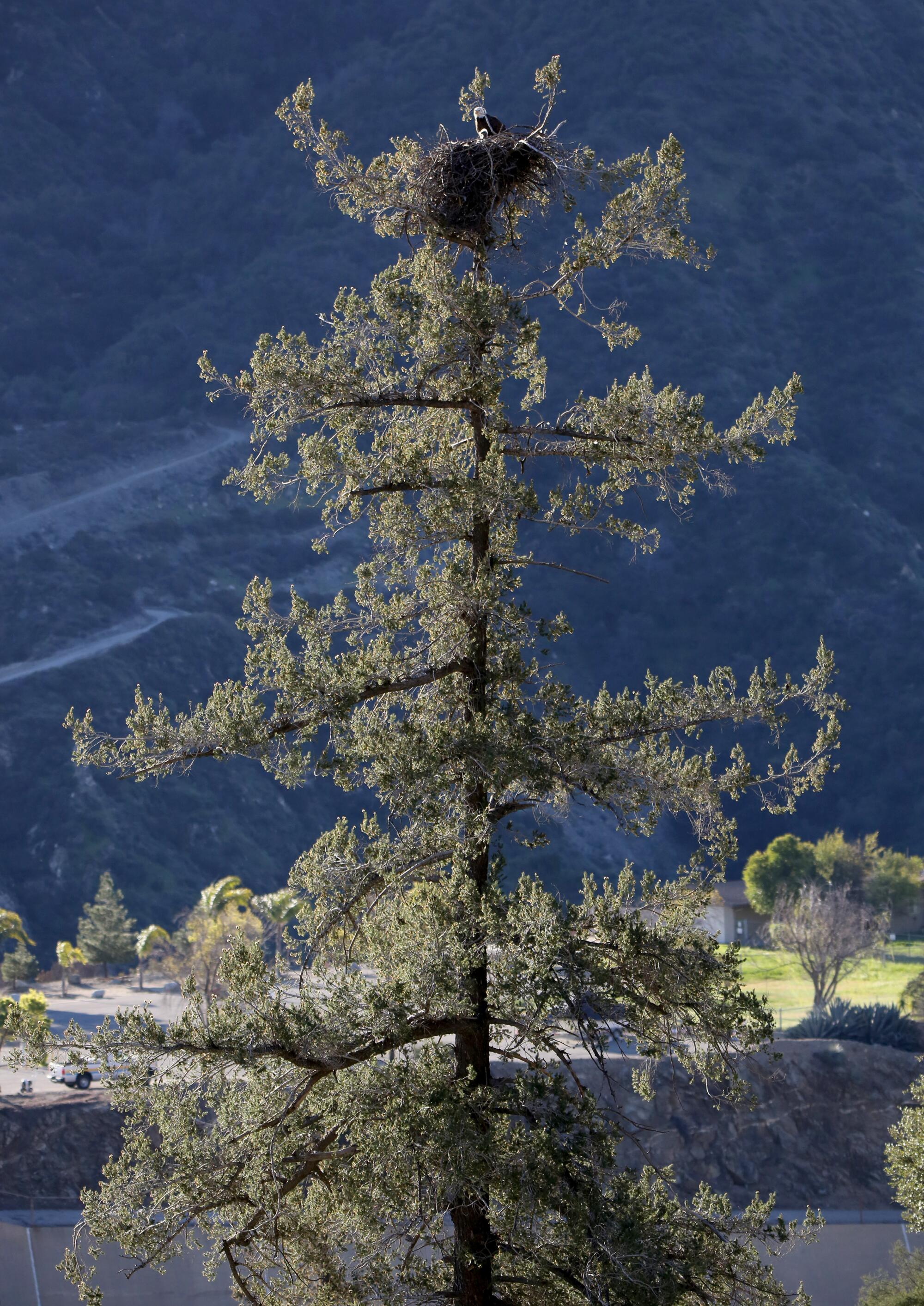
Many raptors are having a hard time in Southern California. Burrowing owls, short-eared owls and golden eagles are extremely sensitive to human presence and steadily disappearing from the landscape.
But bald eagles, now thriving in the Channel Islands and Santa Catalina Island after they were reintroduced there nearly four decades ago, are following their natural instinct to disperse and discovering new habitat on the mainland.
For instance, a pair of eagles that hatched on Santa Rosa Island off the coast of Santa Barbara recently reared eaglets roughly 45 miles to the east in the Orange County residential area of Anaheim Hills. They nested in the upper reaches of a eucalyptus tree with panoramic views of rush-hour traffic on the 91 Freeway.
Near the city of Big Bear Lake in the San Bernardino Mountains, a hidden camera has streamed popular, intimate scenes of adult bald eagles building a nest, laying eggs, feeding babies and circling nearby as they learned to fly — or even tumbled to their deaths.
Trouble is, that nest overlooks the last parcel of undeveloped lakefront property in Big Bear Valley, which is the focus of an ambitious subdivision proposal that is testing the resolve of San Bernardino County policymakers attempting to preserve the area’s nesting eagles, while upholding property rights and commerce.
Bald eagles are among the few raptors that are unafraid to dive head on into humanity.... Eventually, there will be eagle families at every reservoir in the state.
— Pete Bloom, biologist
Big Bear Lake is among dozens of reservoirs built from the 1920s to the 1960s that are now havens for eagles. In the Sacramento area, wildlife authorities posted warning signs and strung up yellow tape to steer eagle fans away from two nests overlooking hiking trails at Lake Natoma, just south of Folsom.
Then there’s Milpitas, just north of San Jose in the bustling heart of Silicon Valley, where a family of bald eagles resides in a redwood tree at an elementary school. U.S. Fish and Wildlife Service officials were honored as local heroes a year ago after they used a bucket-truck ladder to rescue a fledgling that had fallen from the nest and was stranded on a branch.

Exactly why bald eagles are choosing to nest close to human activity remains a biological mystery. But raptor experts suggest that the birds have become less wary of humans after decades of interactions with them during recovery efforts.
“Today’s adult bald eagles have been in close proximity with humans for a variety of reasons for several years now,” said Dan Cooper, a consulting biologist and expert on the plants and animals of Los Angeles County. “We may be seeing the results of repeated close encounters with humans during fittings of number tags on their legs, blood sampling, reintroduction efforts, captive breeding programs and installations of nest cams.”
Pete Bloom, a biologist who has banded raptors in Orange County for 50 years, agrees, and adds that the raptors are extremely opportunistic feeders. When there isn’t fish available, they use their powerful curved beaks and razor-sharp talons to catch — or steal from smaller raptors — waterfowl, squirrels, mice and carrion. But sometimes a landfill will do.
“Bald eagles are among the few raptors that are unafraid to dive head on into humanity,” he said. “They are predators, but roughly 50% of their diet is scavenged. In Alaska, they often feast on wolf kills. Elsewhere, they hang out at garbage dumps.
“So, their populations will continue to grow,” he said. “Eventually, there will be eagle families at every reservoir in the state.”
::
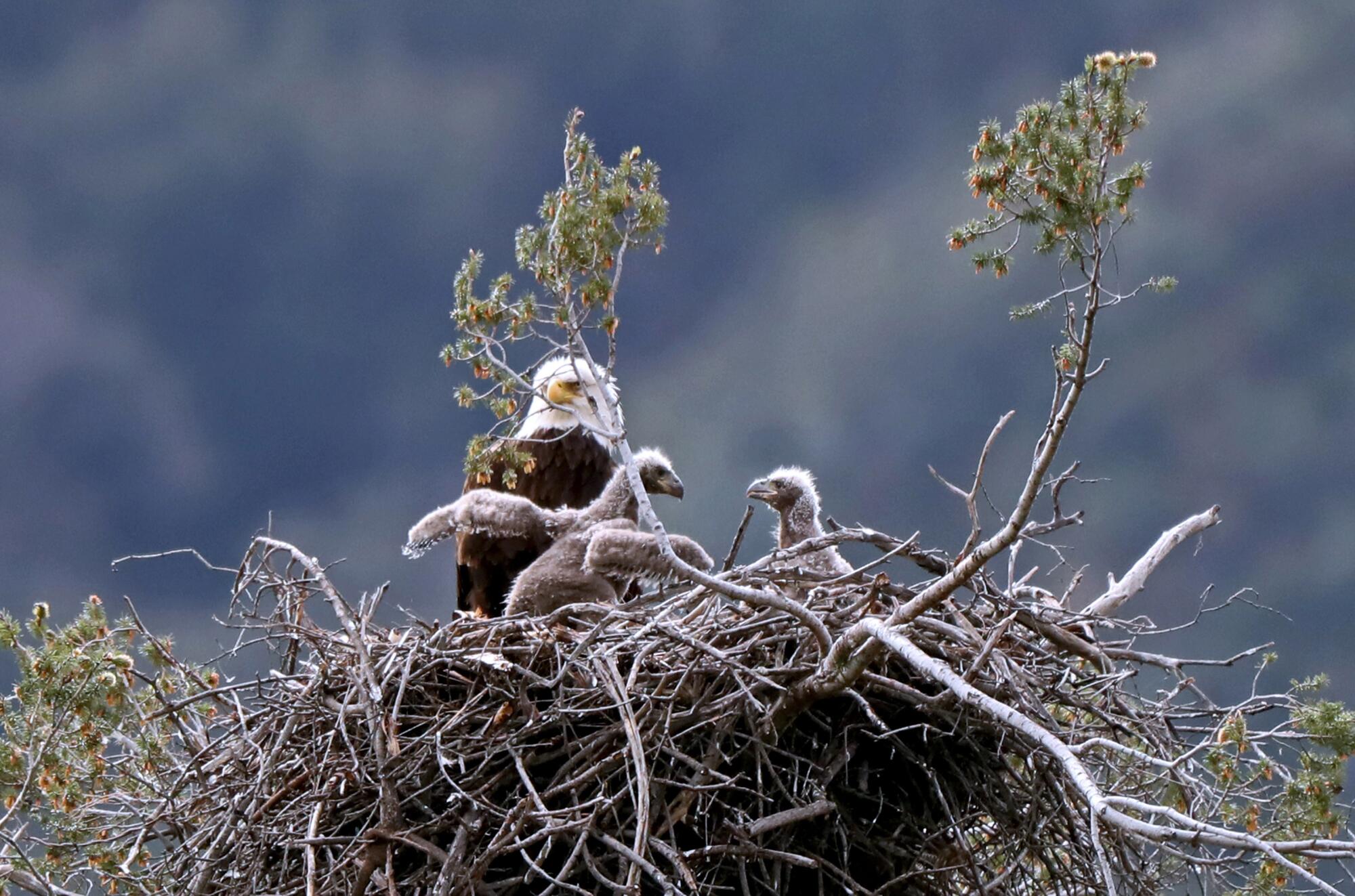
In 1782, the Continental Congress made the bald eagle the national emblem, the living embodiment of honesty, courage and power.
Yet few birds have elicited such strongly opposing views. Its tendency to rob prey from smaller raptors moved Benjamin Franklin to suggest the bird was of “bad moral character.”
As the U.S. population grew, they were reviled as nuisance predators and routinely shot and driven from their treetop aeries by logging, farming and home building. By the 1950s, the spread of the pesticide DDT, which thins eagle eggshells, had led to a catastrophic decline. The iconic raptors plummeted from an estimated half a million nesting pairs at the time of the European settlement to 417 in 1963.
Its flight to recovery began with a ban on DDT in 1972 and stringent protections under the 1973 Endangered Species Act at a time when the population of nesting eagles in California had dropped to 20 pairs. Since then, tens of millions of dollars have been spent on eagle recovery programs by federal, state and nonprofit groups.
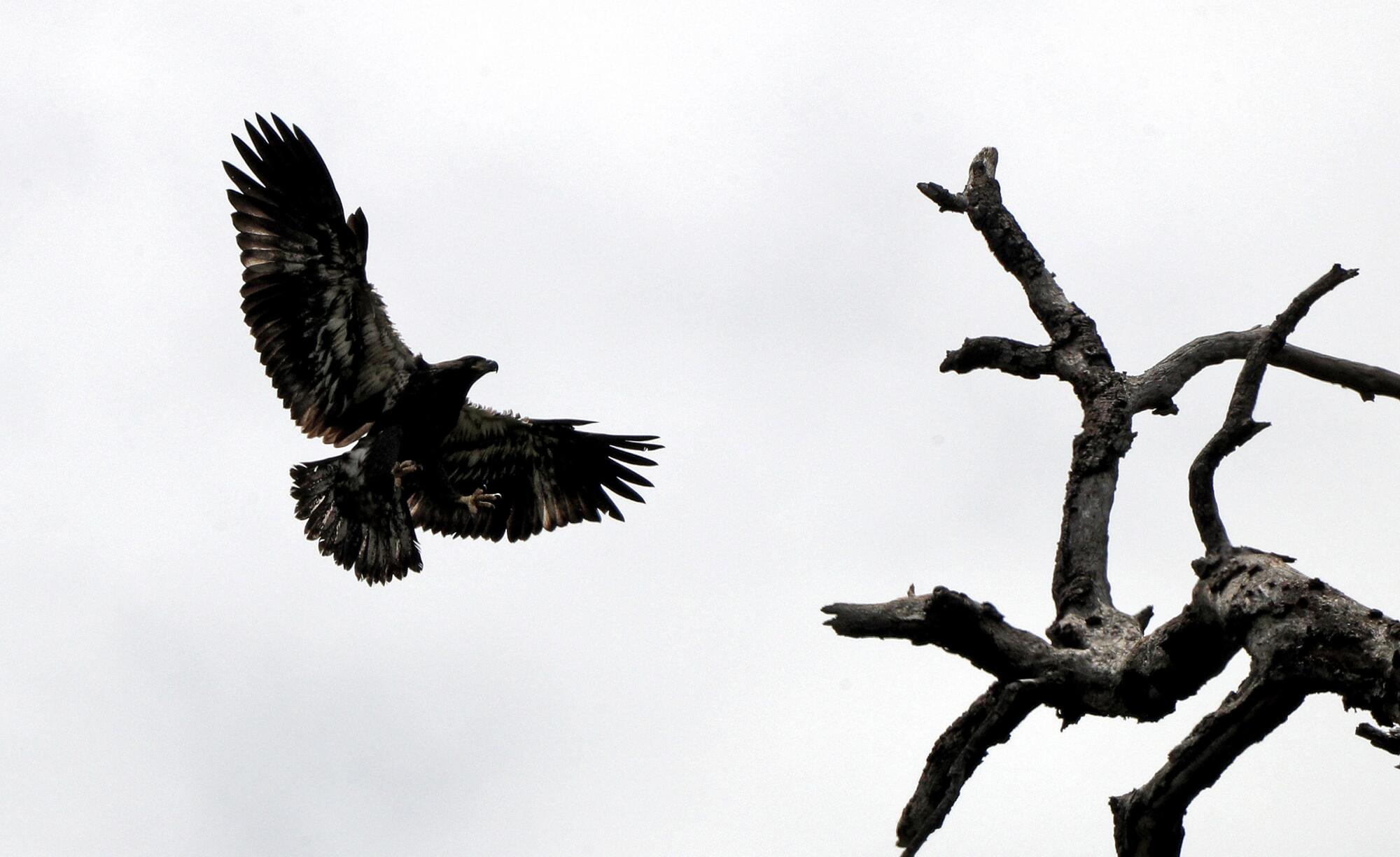
In the 1980s, scientists began to reintroduce bald eagles to the Channel Islands by helicoptering into the nests, dangling from a 100-foot cable, rescuing the fragile eggs and substituting them with fake ones. The eggs were incubated in a lab, and the chicks returned to the nest as soon as they hatched.
Today, more than 60 eagles live on the Channel Islands and Santa Catalina Island, where 24 chicks have fledged from nests this year, making for the most successful breeding season since recovery began over 35 years ago.
A resounding conservation success story nationwide, the bald eagle was taken off the endangered species list in 2007.
::
California is rich in wildlife. Trouble is, wherever you go to see it, the air is filled with the roar of modern congestion.
— Neil Smith, photographer
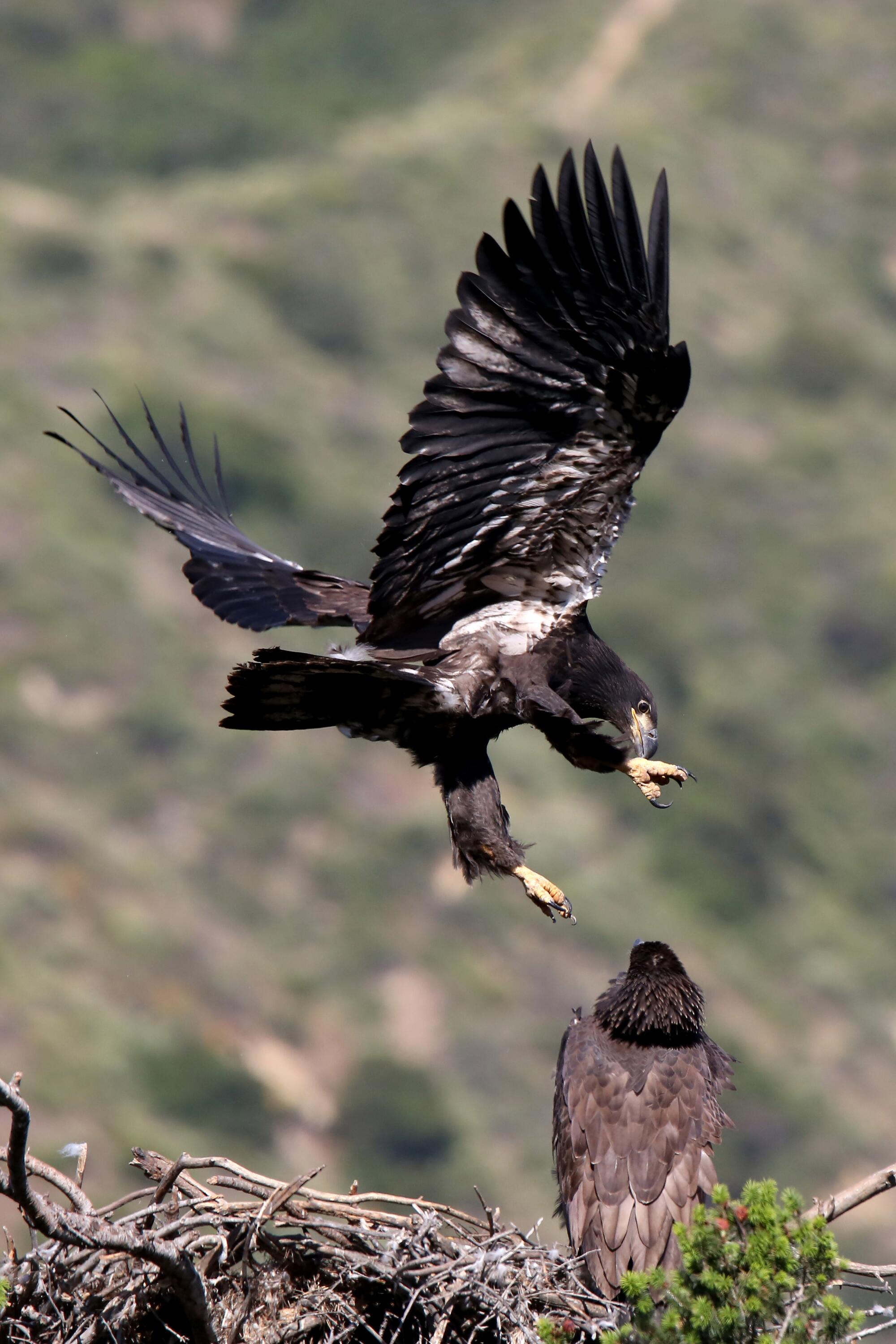
One of the parent bald eagles nesting above Azusa was a male chick when Bloom banded it in 2012 in a nest at Irvine Lake, an Orange County reservoir, about 40 miles to the south. It was probably produced by eagles that had left the islands.
Four years later, it found a mate, and together they began searching for suitable trees in the San Gabriels in which to start a family. Forest Service officials say that in 2017 they took over a blue heron nest overlooking the reservoir at San Gabriel Dam and produced two offspring. A year later, that nest collapsed in strong winds, and at least one chick did not survive.
They quickly built a new nest 110 feet above the ground in a nearby Coulter pine slightly closer to Highway 39. The nearby dirt pullout became a hot spot for photographers eager to catch the antics of juveniles as they matured.
“They have clashing personalities,” photographer Neil Smith, 66, said one morning while setting up a tripod. “One of them is larger, rambunctious and had a tendency to flap hard, rise several feet into the air, and then plop down, nearly biffing his sibling out of the nest.”
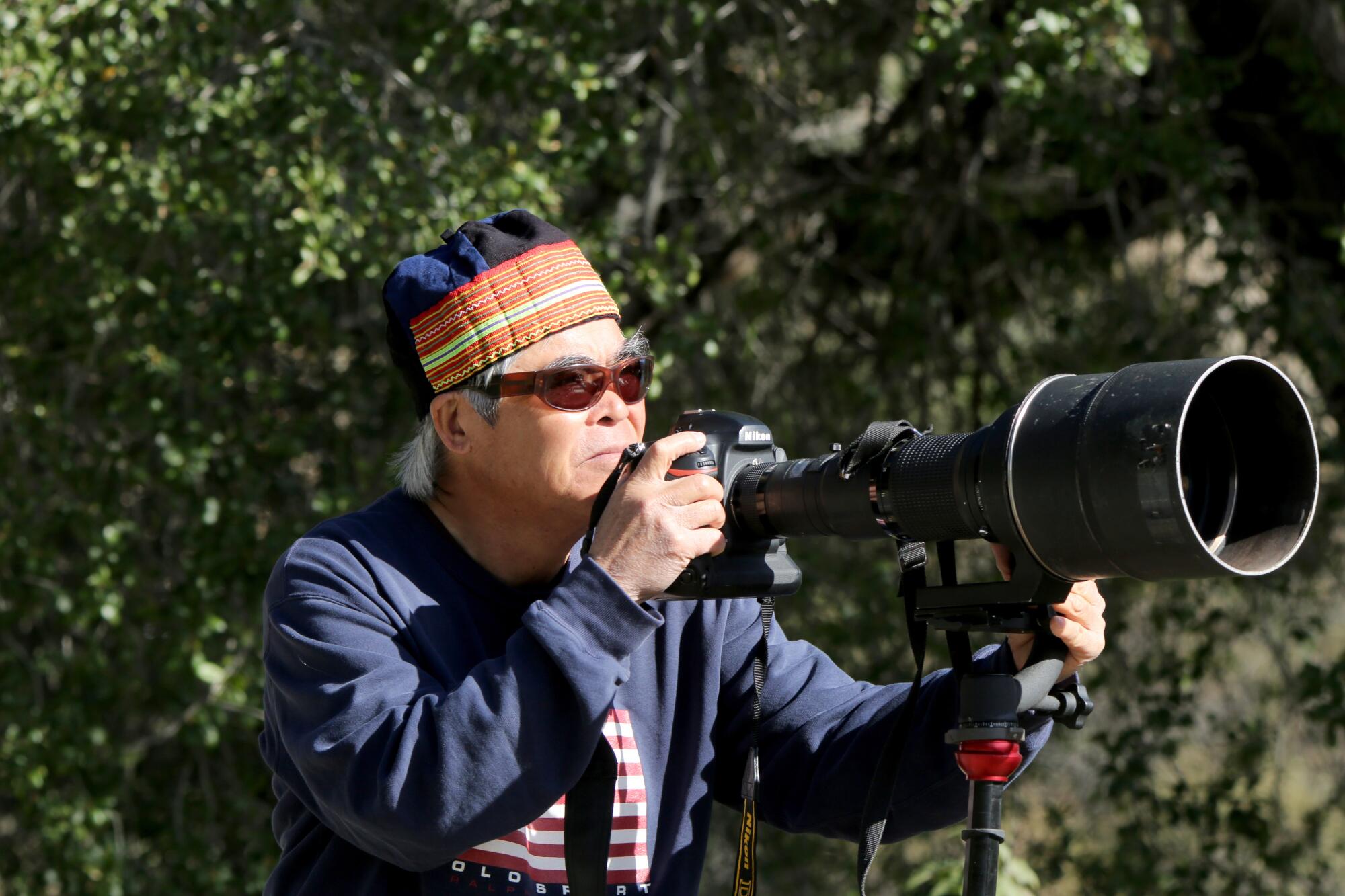
But their shrieks were usually drowned out by the din of passing cars, trucks, motorcycles and heavy machinery.
“California is rich in wildlife. Trouble is, wherever you go to see it, the air is filled with the roar of modern congestion,” Smith grumbled, peering through a camera equipped with a telephoto lens and directional microphone. “So, grabbing some compelling natural sounds to go with your dramatic images is a real battle.”
Aching for a good shot, Smith, who moved to the United States from England, muttered: “Come on, mate, turn around and face the camera. A photo of a bald eagle is no good unless you can see the yellow of its eyes.”
::
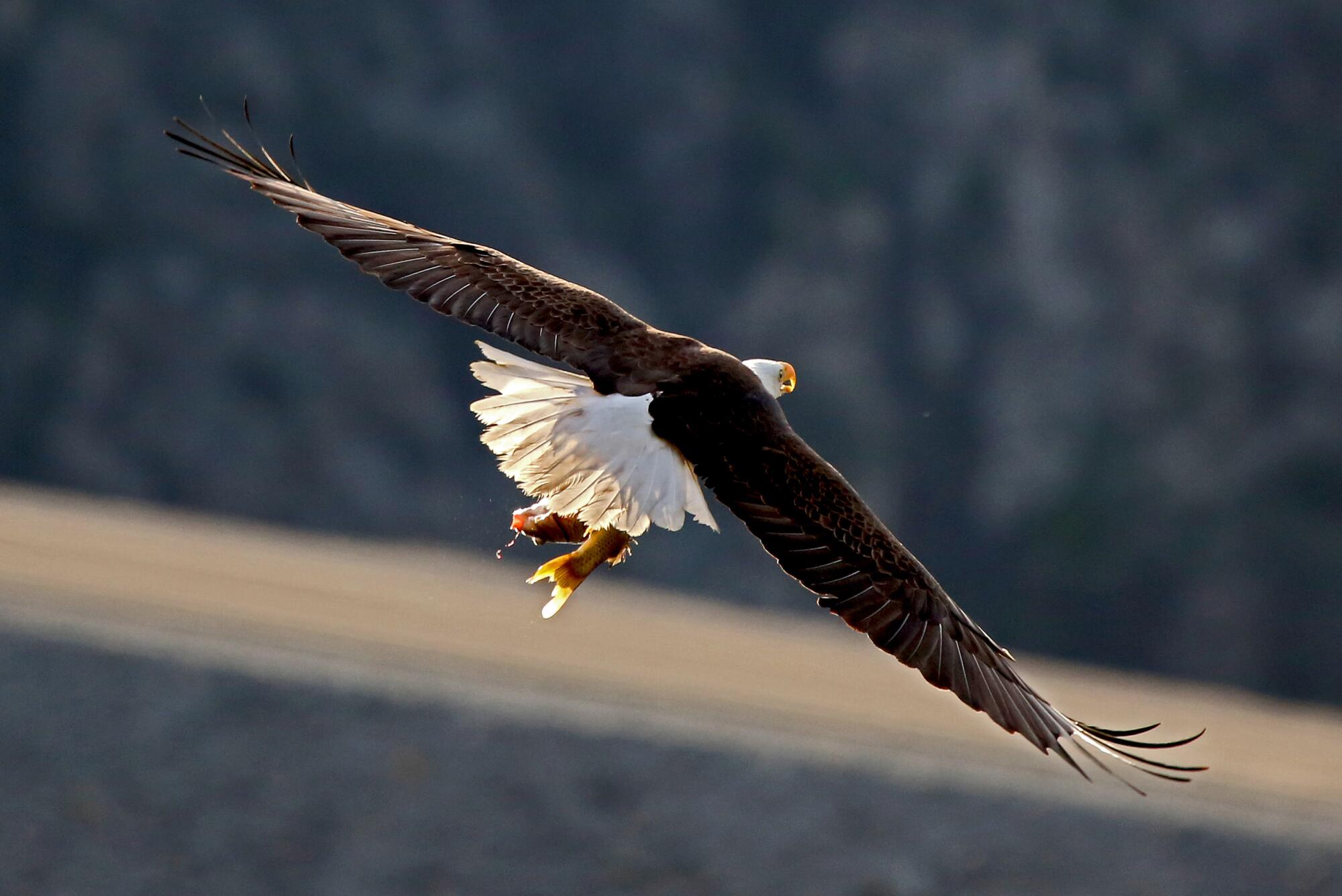
In a squat building in a business park in Camarillo, Rene Corado opened museum drawers filled with bald eagle eggs plucked from nests across the nation over the last 150 years by research biologists. The collections manager held one of the tennis-ball-sized eggs up to a light and said, “This one was collected in 1897 at Zuma Beach, in Los Angeles County. Bald eagles were everywhere back then.”
The varying thickness of the shells of these fragile natural treasures at the Western Foundation of Vertebrate Zoology, which houses one of the largest collections of eggs and nests on earth, chronicles the roller-coaster modern history of a species with a mysterious power to tug at the human psyche.
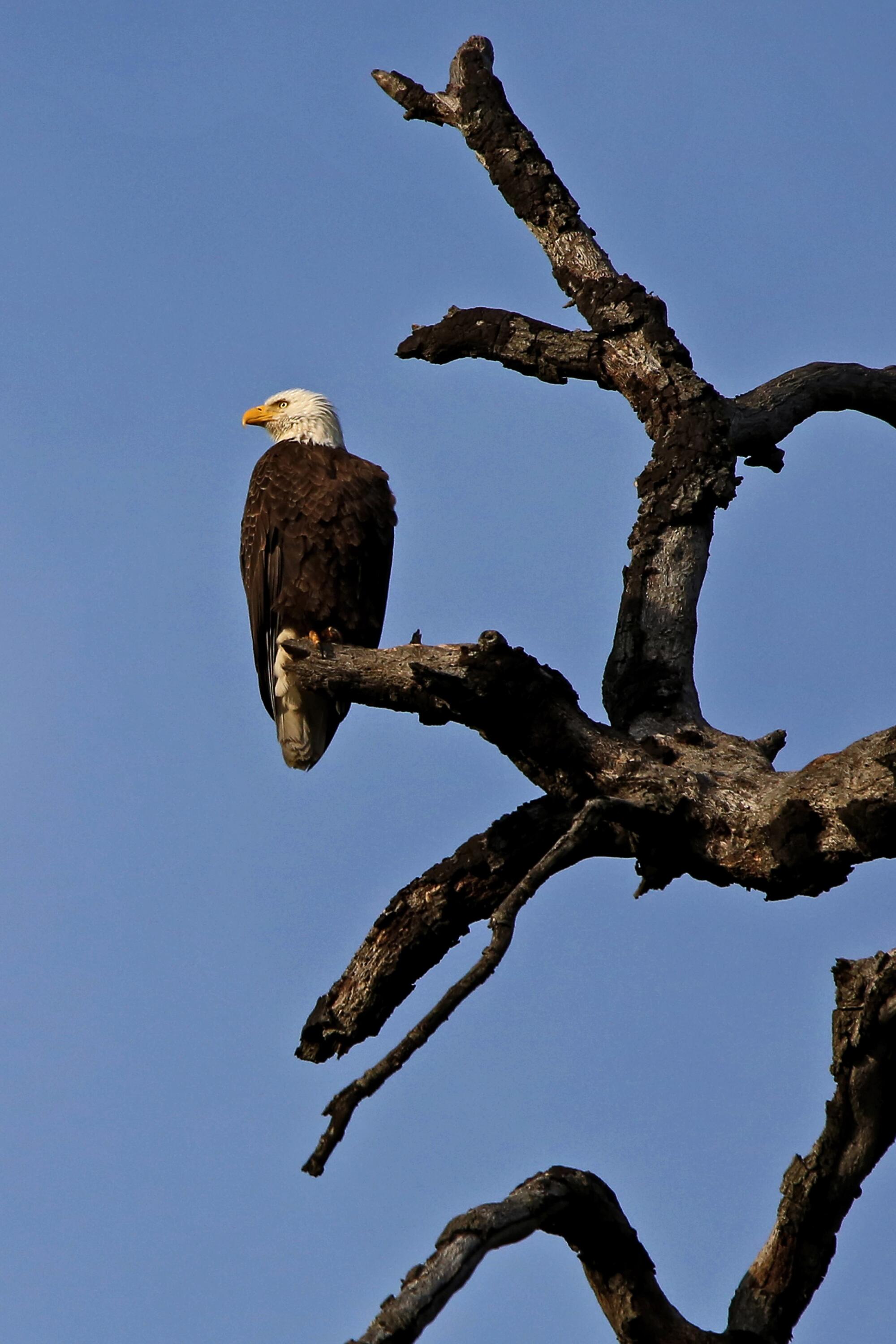
When asked, “What makes bald eagles so special?” Linnea Hall, executive director of the foundation, smiled and, with a twinkle in her eyes, said, “Let me tell you a little story.”
“A few years ago, the Oxnard Rotary held its monthly luncheon here,” she said. “At the appointed hour, one of its officers asked if we had an American flag, which was needed to make the Pledge of Allegiance.”
“We didn’t have an American flag, so I had to think fast,” she recalled. “Turning to Rene, I whispered, ‘Please bring a mounted eagle from a display case.’ ”
Moments later, Corado handed her a 3-foot-tall specimen mounted in New Jersey in 1925. Hall cradled it in her arms and asked, “Will this do?”
After a hearty applause, 60 Rotary members rose to their feet and recited the pledge, hands over hearts. She stood as still as a flagpole until they sat down.
More to Read
Sign up for Essential California
The most important California stories and recommendations in your inbox every morning.
You may occasionally receive promotional content from the Los Angeles Times.

